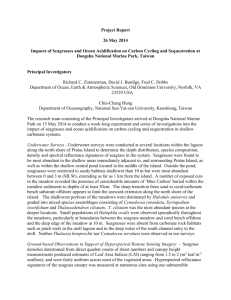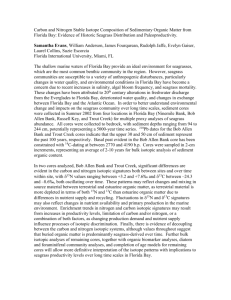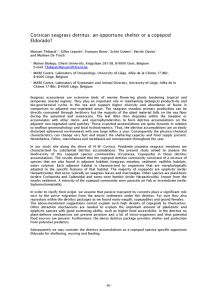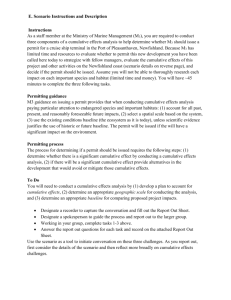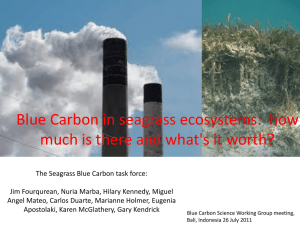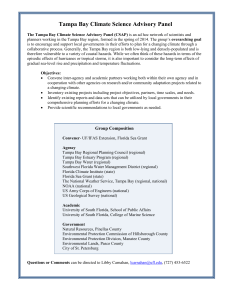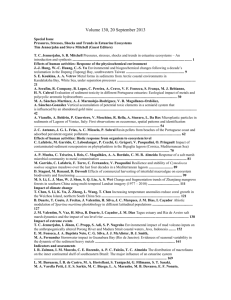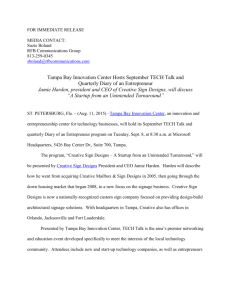BH-3 Seagrass Scars and Transplanting_Final Draft Dec 17 2015
advertisement
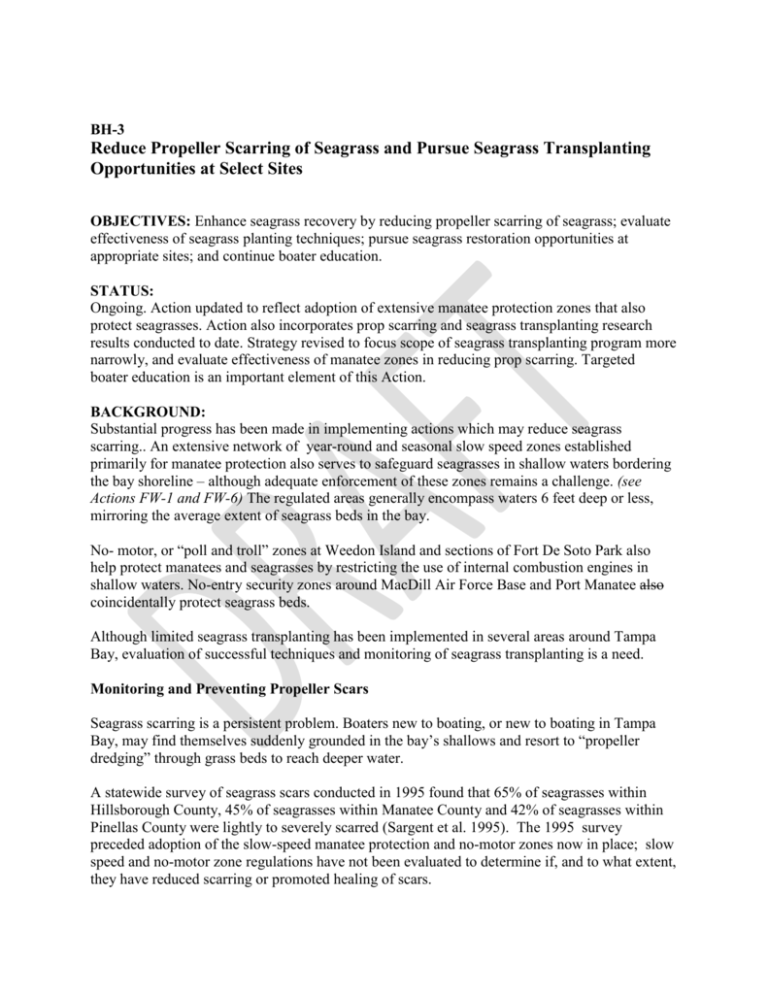
BH-3 Reduce Propeller Scarring of Seagrass and Pursue Seagrass Transplanting Opportunities at Select Sites OBJECTIVES: Enhance seagrass recovery by reducing propeller scarring of seagrass; evaluate effectiveness of seagrass planting techniques; pursue seagrass restoration opportunities at appropriate sites; and continue boater education. STATUS: Ongoing. Action updated to reflect adoption of extensive manatee protection zones that also protect seagrasses. Action also incorporates prop scarring and seagrass transplanting research results conducted to date. Strategy revised to focus scope of seagrass transplanting program more narrowly, and evaluate effectiveness of manatee zones in reducing prop scarring. Targeted boater education is an important element of this Action. BACKGROUND: Substantial progress has been made in implementing actions which may reduce seagrass scarring.. An extensive network of year-round and seasonal slow speed zones established primarily for manatee protection also serves to safeguard seagrasses in shallow waters bordering the bay shoreline – although adequate enforcement of these zones remains a challenge. (see Actions FW-1 and FW-6) The regulated areas generally encompass waters 6 feet deep or less, mirroring the average extent of seagrass beds in the bay. No- motor, or “poll and troll” zones at Weedon Island and sections of Fort De Soto Park also help protect manatees and seagrasses by restricting the use of internal combustion engines in shallow waters. No-entry security zones around MacDill Air Force Base and Port Manatee also coincidentally protect seagrass beds. Although limited seagrass transplanting has been implemented in several areas around Tampa Bay, evaluation of successful techniques and monitoring of seagrass transplanting is a need. Monitoring and Preventing Propeller Scars Seagrass scarring is a persistent problem. Boaters new to boating, or new to boating in Tampa Bay, may find themselves suddenly grounded in the bay’s shallows and resort to “propeller dredging” through grass beds to reach deeper water. A statewide survey of seagrass scars conducted in 1995 found that 65% of seagrasses within Hillsborough County, 45% of seagrasses within Manatee County and 42% of seagrasses within Pinellas County were lightly to severely scarred (Sargent et al. 1995). The 1995 survey preceded adoption of the slow-speed manatee protection and no-motor zones now in place; slow speed and no-motor zone regulations have not been evaluated to determine if, and to what extent, they have reduced scarring or promoted healing of scars. Initial studies indicated that scarred beds may take 3.6 to 6.4 years to return to normal density, if no additional damage occurs during that period (Sargent et al. 1995). However, more recent research conducted by EPC and USF in the Cockroach Bay Aquatic Preserve showed that prop scars healed rapidly (Thorne et al, 2012). The EPC study, which utilized side-scan sonar, found that Halodule wrightii (shoal grass) recolonized scarred areas within 6 months. Recovery also was observed in Thalassia testudinum (turtle grass) beds. Pinellas County officials also reported success with using “sediment tubes” to facilitate regrowth of Halodule in prop scars, as part of mitigation for the Belleair Beach Causeway Bridge. However, more research is needed to determine whether these results can be reliably duplicated in other scarred areas, with different sediment types and currents that may cause scouring, and for slower-growing Thalassia or Syringoidum filiforme (manatee grass). Although the impacts of scars on fish and shellfish have not been well studied, research conducted in 2002 in both Tampa Bay and Charlotte Harbor showed no significant declines in species abundance in seagrass beds with up to 50% scarring. (Bell et al. 2002). Despite these results, the need for safe navigation in shallow waters to prevent scarring in the first place remains, and should be a continued focus of boater education efforts. Refining Techniques for Transplanting Seagrasses Only about 100 acres of the 20,000-acre increase in bay seagrasses since 1990 has resulted from transplanting efforts – water quality improvements account for the majority of the gains. Regaining seagrasses naturally through nutrient management should continue to be the primary focus of restoration efforts. However, transplanting may be a locally important tool for “jump-starting” restoration where seagrass recovery is lagging, sudden losses occur (due to a spill or extreme weather event, for example), or as mitigation for unavoidable impacts. Several methods of transplanting seagrasses have been employed in Tampa Bay. Early efforts involving small units of seagrass had poor survival rates, as the newly planted grasses were easily washed away by tides and currents. More recent projects have had success transplanting larger clumps or “sods” of seagrass that include the native soil and intact root systems. These units – measuring about 8 inches by 8 inches –are often able to withstand more turbulent water conditions until the grass is fully established. In a multi-year project at MacDill Air Force Base conducted by Tampa Bay Watch and the City of Tampa, Syringodium filiforme from a natural “donor site” was transplanted to a nearby location using the sod technique. After two years, seagrass coverage in the transplant area increased 28-fold. Nearly a decade after the first transplanting at this location, the seagrass cover has continued to expand. An additional quarter-acre of Syringodium was transplanted in six plots in 2012 through EPC and Tampa Bay Watch; by late 2015, a 75% increase was observed. It is difficult to determine whether this recovery, and similar restoration/mitigation projects, is the result of natural recruitment or transplanting activities. Seagrass survival is influenced by multiple factors, including water clarity, sediment type, rainfall, epiphyte coverage, and wave energy. The location and depth at which the plantings occur may be more important than the technique used. Just like land-based trees and plants require specific environmental conditions, like hours of direct sunlight or soil type, transplanted seagrass – regardless of technique - will not survive if the location is not conducive to fostering seagrass growth. Mitigation for construction-related impacts typically requires permittees to track and report survival to the permitting agencies for a limited period only. Long-term monitoring (greater than 3 years) of restoration and mitigation projects is needed to determine the most cost-effective and successful methods, and to identify appropriate planting strategies. STRATEGY: Activities to assess seagrass scar reduction efforts and enhance scar reduction (some activities can occur simultaneously): Activity 1 Develop and implement a study to evaluate the effectiveness of no-motor, slow speed zones and voluntary “seagrass caution areas” in reducing propeller scars. Identify and prioritize scarring “hot spots” around the bay to reduce repeated impact. Responsible parties: Develop and conduct evaluation of slow speed zones for reducing prop scarring: TBEP (lead for Tampa Bay) with Southwest Florida Seagrass Working Group. Evaluation can be included as a task in the seagrass chapter for the Tampa Bay Habitat Masterplan Update Identify and prioritize scarring ‘hot spots’: TBEP (lead for Tampa Bay) with Southwest Florida Seagrass Working Group. Development of a “hot spot map”, possibly using SWFWMD aerial photographs, will be included as part of the seagrass chapter in the Habitat Masterplan Update. Identify best management techniques to reduce seagrass scarring: TBEP (lead for Tampa Bay) with Southwest Florida Seagrass Working Group, as part of the Tampa Bay Habitat Masterplan Timeframe: The Habitat Masterplan will be initiated in 2017 and finalized in 2019 Cost and potential funding sources: $$-$$$ CWA 320 funds Location: Baywide Benefit/Performance measure: Identification of ‘best practices’ to reduce seagrass scarring and ‘hot spots’ of seagrass scarring Results: Identification of seagrass scarring “hot spots” and effective techniques to reduce seagrass scarring will direct restoration and protection efforts more cost effectively Deliverables: Report on best practices to reduce seagrass scarring: TBEP Scarring “hot spot” map: TBEP Activity 2 Continue to maintain effective seagrass scarring reduction practices. Direct new efforts to seagrass scarring “hot spots.” Responsible parties: Local and state governments including Pinellas, Hillsborough and Manatee counties and the Florida Department of Environmental Protection are currently managing slow speed zones. Timeframe: Ongoing for current zones. New efforts, if warranted, in ‘hot spots’ initiated by 2023. Cost and potential funding sources: $$ per year (local government resources; FDEP uses boater registration revenues to help support law enforcement including patrolling slow speed zones). Location: Baywide Benefit/Performance measure: Increased protection of seagrass beds from propeller scarring. Scar reduction in identified ‘hot spots’. Results: Maintenance and enforcement of effective seagrass scarring reduction actions. Deliverables: Report on ongoing and new seagrass scarring reduction efforts 5 years after the efforts are implemented (TBEP). Activity 3 Continue to refine and expand boater education programs to more effectively reach target audiences, which includes new boaters and boaters new to Tampa Bay. Improve boater education for rental boat operators and customers. Support and promote the use of digital technologies (including electronic chart displays, smartphones and other emerging platforms) to provide real-time information to boaters and alert them when they are entering slow-speed or no-motor zones (see Action FW-6). Responsible parties: TBEP lead (through the Manatee Awareness Coalition), FWC, FDEP (through its aquatic preserves and state parks) Timeframe: Ongoing for TBEP education materials. Digital technologies initiating by 2023. Cost and potential funding sources: TBEP funding via CWA section 320 for Boaters Guides and other boater education materials ($) Bay Mini-Grants supported by Tampa Bay license plate revenues ($) Enhancement of digital technologies (product providers) Location: Baywide Benefit/Performance measure: Increased protection of seagrass beds from propeller scarring Results: Enhanced awareness of boaters regarding importance of seagrass and seagrass scarring reduction actions Deliverables: Boater education materials/Boaters Guides (TBEP) Other education materials (TBEP Bay Mini-Grants) Enhanced digital maps and technology (product providers) Activities to assess seagrass transplanting techniques: Activity 4 Develop and implement a long-term monitoring program for seagrass transplanting and mitigation to assess optimal conditions and techniques for success. Develop a map of areas in Tampa Bay where seagrass transplanting could assist in jump-starting seagrass recovery. Responsible parties: Monitoring design: TBEP (lead) as an element of the Habitat Master Plan. Monitoring implementation: Local entities currently participating in the annual seagrass transect monitoring program including Tampa Bay Watch, FWC, Southwest Florida Seagrass Working Group members, FDEP, public or private entities conducting seagrass transplanting for mitigation Map of seagrass transplanting optimal sites: TBEP (lead) Timeframe: Develop monitoring design by 2019; Initiate monitoring program within 2 years of design completion; Evaluate monitoring results after 5 years of implementation Create map of optimal transplant sites by 2025 Cost and potential funding sources: Design: TBEP 320 funds ($) Implementation: no 320 funds; local entities staff time ($$) Evaluate monitoring results: TBEP 320 funds for staff time ($) Location: Baywide Benefit/Performance measure: Increased seagrass transplanting success Results: Coordinated, comprehensive approach to seagrass transplanting that employs most effective techniques in locations with greatest likelihood of success Deliverables: Monitoring design document (TBEP) Report on monitoring results after 5 years (TBEP) Map of seagrass transplanting optimal sites (TBEP) 6 Accomplishments on BH-3 1996-2006 Action Title: Reduce propeller scarring of seagrass and pursue seagrass transplanting opportunities at select sites TBEP played a role in the following: Actions taken to protect manatees in shallow water also serve to reduce propeller scarring of seagrass. See Accomplishments for Action FW-1. Conducted an assessment of physical impacts to habitats in Tampa Bay. Results of an aerial survey conducted in 1992 indicated that 35% of the total seagrass area in Tampa Bay exhibited heavy and moderately heavy damage from prop scars, while more than 40% of the seagrass areas exhibited sparse or no scarring. TBEP Technical Report #0393. Assisted local government partners in sponsoring forums and workshops with recreational boaters to explore “pole and troll” zones in key areas of the bay. Funded an analysis of prop scar damage at the Ft Desoto Aquatic Habitat Management Area in 1992. Results of this analysis were used by Pinellas County to develop ‘go slow’ and combustion engine exclusion areas. TBEP Technical Report #05-94. Results of a 5year assessment indicated that the placement of signs, coupled with full-time, on-water presence of law enforcement officers reduced the rate of scarring. Regularly stocked marinas, boat dealers and tackle shops throughout Tampa Bay with boating guides and other education materials, including location and extent of shallow seagrass beds. Surveys completed by Bay-Friendly Boater kit recipients indicate that the kits provided valuable information that increased their knowledge, especially with regard to the shallow nature of the bay, and the need for caution when boating in shallow water to protect seagrasses and manatees. Funded an assessment of the status and ecology of Florida Gulf Coast seagrass communities, including an evaluation of the extent of seagrass scarring in Florida estuaries. TBEP Technical Report #03-04. 2006-2016 Action Title: Reduce propeller scarring of seagrass and pursue seagrass transplanting opportunities at select sites TBEP played a role in the following: TBEP and multiple partners were awarded several grants to conduct elements of a Longshore Bar Restoration Project, designed to mitigate wave energy and create conditions conducive to seagrass recovery behind the restored bars. Funding sources include the Hillsborough County Pollution Recovery Trust Fund to examine wave energy 7 effects; FDEP to examine historical changes in offshore bars; US Fish and Wildlife Service to support engineering studies; and in-kind services from USGS, the Tampa Port Authority, Mote Marine Lab and Coastal Resources Group, Inc. Grants include support for construction of the experimental longshore bars (Gulf of Mexico Program grant and PCEF grant) and for seagrass planting (HC Pollution Recovery Trust Fund). Work on this large project was initiated in early 2005, and concluded in 2013. TBEP Technical Report #06-13. Supported experimental plantings of large (8” by 8”) manatee grass sods as part of the Longshore Bar project. Two years after the plantings, there was a 28x increase in area covered over that originally planted. Several of the restored sods were expanding at a rate similar to natural growing manatee grass areas. TBEP Technical Report #01-09. An extensive network of manatee protection zones in shallow seagrass areas has been established in Tampa Bay, along with two no-entry refuges (around power plants). These zones are a combination of federal, state and local designations, but all require boaters to go slow or pole/troll in shallow waters where manatees feed and rest. These zones were approved and posted in FY 04, 05 and 06, and have been maintained without alteration since their initial creation. TBEP’s Manatee Awareness Committee spearheaded an important project to incorporate and display manatee and seagrass protection zones in Tampa Bay on electronic marine charts for recreational boaters. The chart manufacturer Garmin became the first private sector partner to include the zones in their electronic navigation systems (FY09). Navionics followed in FY10 by adding the local zones to their popular “Fish N’ Chip” for chart plotters. Boaters using these units for navigation will see manatee zone boundaries highlighted as they scroll over portions of Tampa Bay where slow speed zones have been established. 8

